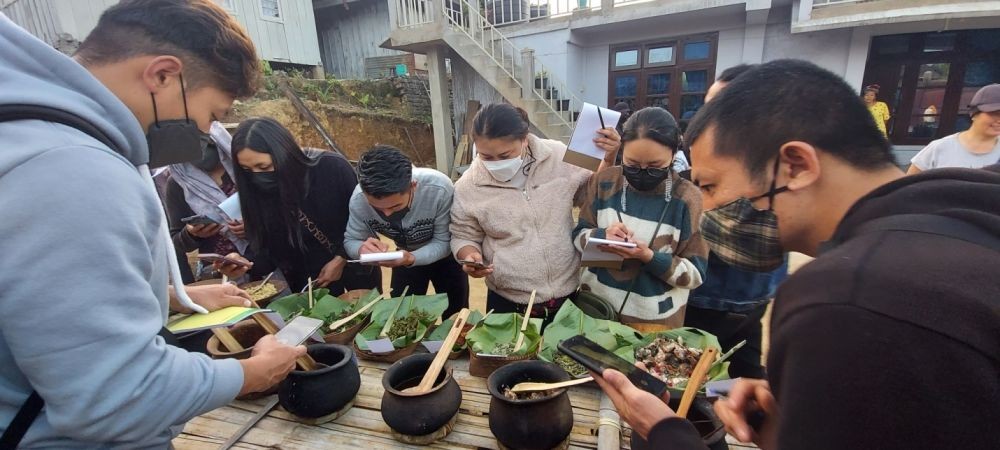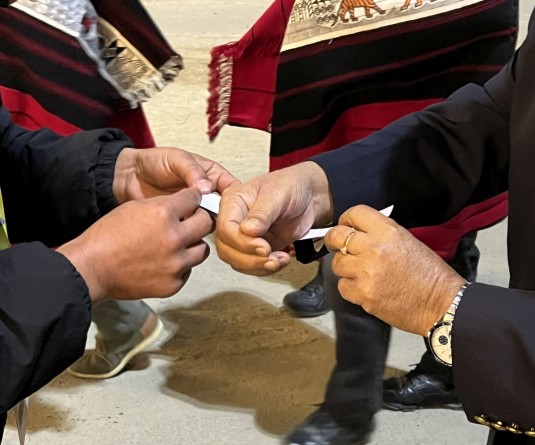Japfü Christian College Staff & Students’ data collection and sample tasting at Süngratsü village, Mokokchung in 2022. (Photo Courtesy: JCC)

Morung Express News
Kohima | August 13
Is it possible to create a food map for Nagaland? In addition to acquiring essential culinary skills for survival, a pioneering Naga Traditional Cuisine Lab at Japfü Christian College (JCC), Kigwema, is embarking on this endeavour as part of its research focus.

Documentation at Mopungchuket village during 2022. (Pic: JCC)
This initiative stems from a three-year UGC Stride Component 1 research project and has subsequently been integrated into the undergraduate course curriculum.
Dr Visakhonü Hibo, Principal of JCC and a force behind the project, highlighted that the JCC community possesses a fervent interest in both gardening and Naga traditional cuisine and thus the research inclination also fell ‘on lines of our palate.’
Why Naga Traditional Cuisine Lab?
Sharing with The Morung Express regarding the conceptualisation of the lab, Dr Hibo observed that modernity has drastically impacted the Naga traditional knowledge system, arguably putting the society and its people at a disadvantage, particularly with regard to ‘sustainable living and economic livelihood.’
With vast experiences in research, teaching and writing, while Naga tribes have generated a great deal of interests among scholars and researchers, a cross-cultural study of food and cuisines to gain new methodological and theoretical insights has not received its due attention, she highlighted.

Tree Tomato grown as sample food source at Japfü Christian College, Kigwema. (Pic: JCC)
Dr Hibo also pointed out that forests play an important role in the culinary knowledge and food ways of the Naga communities.
“The forest produce ranging from wild herbs and vegetables to large game have occupied an important place in the subsistence pattern. Thus, one of the objectives of the research is also to establish the relevance of forest produce in the Naga traditional cuisine” she said.
The study of traditional cuisines, food habits and diverse foodlore of the Naga communities which in itself will be a herculean task, can shed light on their history, migration pattern and cultural contact.
Hence, the Principal said it was a humble attempt to locate the Naga tribes of Nagaland within a broad theoretical and methodological framework of sustainable development and traditional knowledge system.

Besides, with Nagaland located in the Indo-Myanmar frontier, indispensable to India’s Act East Policy (EAP), the study of traditional cuisines can play an important role in sustainable development, food security and climate change, since all these variables are interconnected, she said.
On the economic livelihood front, Nagaland and other North-East states remain untapped potential as a “food tourism” hotspot which can play a crucial role in India’s EAP to develop the region, Dr Hibo added.
Ingenuity and cultural exchange
While available records on the Naga tribes show similarities in agricultural practices, food habits, food lore and taboos among the Naga groups spread across the different regions and states, she maintained that ‘each community has indigenous culinary knowledge developed according to their own genius over a period of time.’
The traditional or indigenous cuisines among the Naga tribes, she noted tend to show elements of both ingenuity and cultural exchange which to a large extent is determined by the ecology, method of food production and procurement, and cultural beliefs and practices.
Besides, Dr Hibo said there are certain specific food and cuisine that have become the cultural expression of particular Naga tribes, ‘sometimes bordering towards ethnic caricatures.’
She cited some instances where bamboo shoot is identified with the Lotha; axone (fermented soybean) with the Sumi; anishi with Ao; muodi (meat chunk cooked in blood) with Angami; kholar (beans) with Yimkhiung; taro (yam) with Konyak etc.
“In fact, cuisines among the Naga tribes have become silent identity assertion amid the burgeoning cultural contact,” added Dr Hibo.
Traditional knowledge system fast disappearing
Meanwhile, Dr Hibo shared with concern that due to modernisation, the food gathering aspect of economic livelihood is fast disappearing affecting the traditional knowledge system and sustainable development
The Naga “cuisine complex” reveals that food gathering is intrinsic to the economic livelihood as a Naga knowledge (and deep connection) of the forest is mainly facilitated by gathering activity - procurement of wild leaves, tubers, herbs, medicinal plants, wild nuts, insects and so on, she maintained.
However, she observed that this dimension of Naga traditional knowledge (forest and livelihood) having far-reaching implication on food security, agro-biodiversity conservation and climate change is witnessing a drastic change.
Thus, Dr Hibo said this study will seek to establish the relationship between Naga traditional cuisines and the age-old practice of food gathering (from the forests), so as to shed light on food security and sustainable practices.
Naga cuisines as nutritional repositories
Although meat occupies an important space in the Naga cuisine adding to its diversity, Dr Hibo said in general, the food of the Nagas is rich in carbohydrates, given the centrality of rice in daily diet.
While Naga traditional cuisines exhibit a smorgasbord of plant-based proteins, she further noted that researchers have identified the medicinal value of various plants, herbs and tubers that are traditionally used as food items or condiments.
‘Naga cuisines are thus nutritional repositories that are yet to be fully explored. One of objectives of this study is to understand the nutritional dimension of Naga traditional cuisines, relating it to health and well-being, she added.
Misconception of Naga cuisines
In diverse country like India, with different food habits and belief system, the food habits of a tribal community like the Nagas at the margins presents a distinct case.
‘Culturally and politically, the food habits and cuisines of the Naga tribes appear as an anomaly when compared to the vastness of the Indian populace in the mainland’ said Dr. Hibo further adding that the perceived strangeness and even “disgust “are many a time a misconception and caricature of the “other” cultures and food habits that are different.
To this end, she said this study will attempt to document the diversity of Naga cuisines and food habits so as to understand the issues of sustainability and food security at a micro-level, but having a nation-wide vision and implications.
She also briefly explained the food lore and food taboo among the Naga tribes that are intrinsic to Naga traditional belief and in some instances continues to this day.
Why let students study?
Dr Hibo said the Naga Traditional Cuisine is healthy, pocket friendly and sustainable as it relies on fields, forests, organic backyard gardening/livestock/ fowls.
She observed that Naga Traditional Cuisine is gaining popularity elsewhere but at ground zero the upcoming generations are sidelining Naga Food which ‘needs re-directing to one’s roots.’
Besides, she maintained that food tourism has huge future scope as tourists crave for Naga foods and also cultural tourism/eco-tourism with Home-stays, serving Naga Food, can become an exciting venture, ushering in sustainable economy vis-à-vis preservation of Naga identity.
Leftovers, especially pork, taste better with every reheat, said Dr Hibo adding that Naga food does not spoil easily, and have the least chance of mass food poisoning.
‘We taste the original meat/vegetable flavour in Naga food, not swamped by spices as in other cuisines.’
The course, she said can invariably enable and equip students to home cook, earn if interested and help reconnect them with their Naga Roots by strengthening and fostering mutual appreciation of each tribe towards Naga brotherhood in the long run.
Besides, Dr Hibo said serious students can become Naga Traditional Cuisine Chefs in established hospitality sectors or become Professors of Practice in Central/State/Private Universities and Colleges as per NEP 2020 possibilities.




.jpg)

